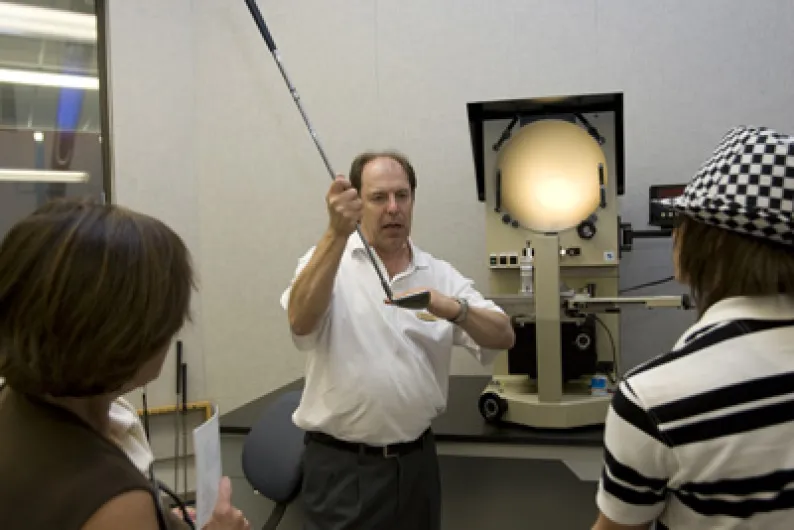Got Grooves? Read This!

-by Rick Jenkins
With much media attention swirling around the new “grooves rule,” we thought it would be helpful to review the rule and clarify how it will affect NJSGA competitions. The rule was announced in 2008 by the USGA and R&A, the worldwide governing bodies that set the Rules of Golf, but has become front and center news recently with the rule’s implementation and reactions by various Tour players.
What is the new rule all about?
Although the complete technical specifications of the new groove requirements are more detailed, the rule essentially boils down to the following two changes:
- The volume of grooves is reduced.
- Groove edge sharpness is reduced for clubs with lofts greater than or equal to 25 degrees.
A common misconception is that “U” shaped grooves will no longer be allowed and must be replaced with “V” shaped grooves. This is not the case. However, any “U” shaped groove must conform to the new specifications for both cross sectional area/spacing and edge radius. The complete technical specifications can be found on the USGA’s web site in the Test Protocols for Equipment section.
The new rule applies to any club for conformance to the cross sectional area/spacing specification, and to any club with a loft of 25 degrees or greater for conformance to the groove edge sharpness specification (in most cases, this means a 5-iron or above). Drivers and putters are exempt from the new specifications.
Why was the rule changed?
The change is designed to reduce spin on shots played from the rough by highly skilled players, and thereby restore the challenge of shots played from the rough to the green. The underlying assumption is that removing this skill enhancement should result in an increase in the importance of driving accuracy.
When does the new rule go into effect?
The new rule became effective January 1, 2010 – but only for certain competitions and only for certain players.
The new rule governing grooves has been adopted as a condition of competition for the 2010 U.S. Open, U.S. Women’s Open and U.S. Senior Open, as well as sectional (final stage) qualifying events for these three championships. The condition will not be in effect at local (first stage) qualifying events for the 2010 U.S. Open or at any of the USGA’s national championships and team competitions that are contested by amateurs only. The USGA will adopt the condition of competition for U.S. Open local qualifying beginning in 2011 and for the national championships and team competitions it conducts for amateur players no later than 2014.
In addition, the PGA Tour (including the Champions and Nationwide Tours), European PGA Tour and other members of the International Federation of PGA Tours, as well as the LPGA, have adopted this condition of competition at their tournaments beginning January 1, 2010. The PGA of America and Augusta National Golf Club have adopted it for the PGA Championship and Masters Tournament, respectively, in 2010.
How does the new rule affect NJSGA competitions in 2010?
It does not. There are no changes to groove specifications required for NJSGA competitions in 2010.
Although the condition of competition will be included in the Rules of Golf as of January 1, 2010 for committees to adopt, the USGA plans to implement the condition over a period of several years, beginning in 2010 with the U.S. Open, U.S. Women’s Open, and U.S. Senior Open (and their sectional, or final stage, qualifying events) and no later than 2014 for the championships and team events it conducts for amateur players. The USGA has recommended that state and regional associations and clubs implement the condition in accordance with this general time frame. However, when this condition is implemented in a broader way, the USGA recommends that it only be used at competitions involving expert players.
So, the NJSGA will follow the situation annually and is likely to implement the new rule as the USGA recommends.
What is the effect of new grooves on the average player?
The changes are expected to have little impact on the general golfing population for three reasons. First, USGA research shows that average golfers playing from the rough hit the green in regulation only 13 percent of the time. Second, two-thirds of golf balls sold are surlyn-covered balls which show little spin effect from different groove designs. Finally, all existing clubs that presently conform to the rules will continue to be deemed conforming through at least 2024, when the rule is expected to become a permanent equipment specification, giving golfers ample time to replace their equipment.
How does a player determine if a club or set of clubs conforms to the new specifications?
The USGA has developed a database that helps players determine if clubs conform to the new specifications, provided the club or set of clubs has not been altered and is “as manufactured.” The database lists all irons and wedges, as well as hybrids and fairway woods, with lofts greater than or equal to 25 degrees that have been evaluated for conformance to the 2010 Rules of Golf. The database is available on the USGA’s Web site here.
Some information courtesy of the USGA. Photo above copyrighted by USGA.
